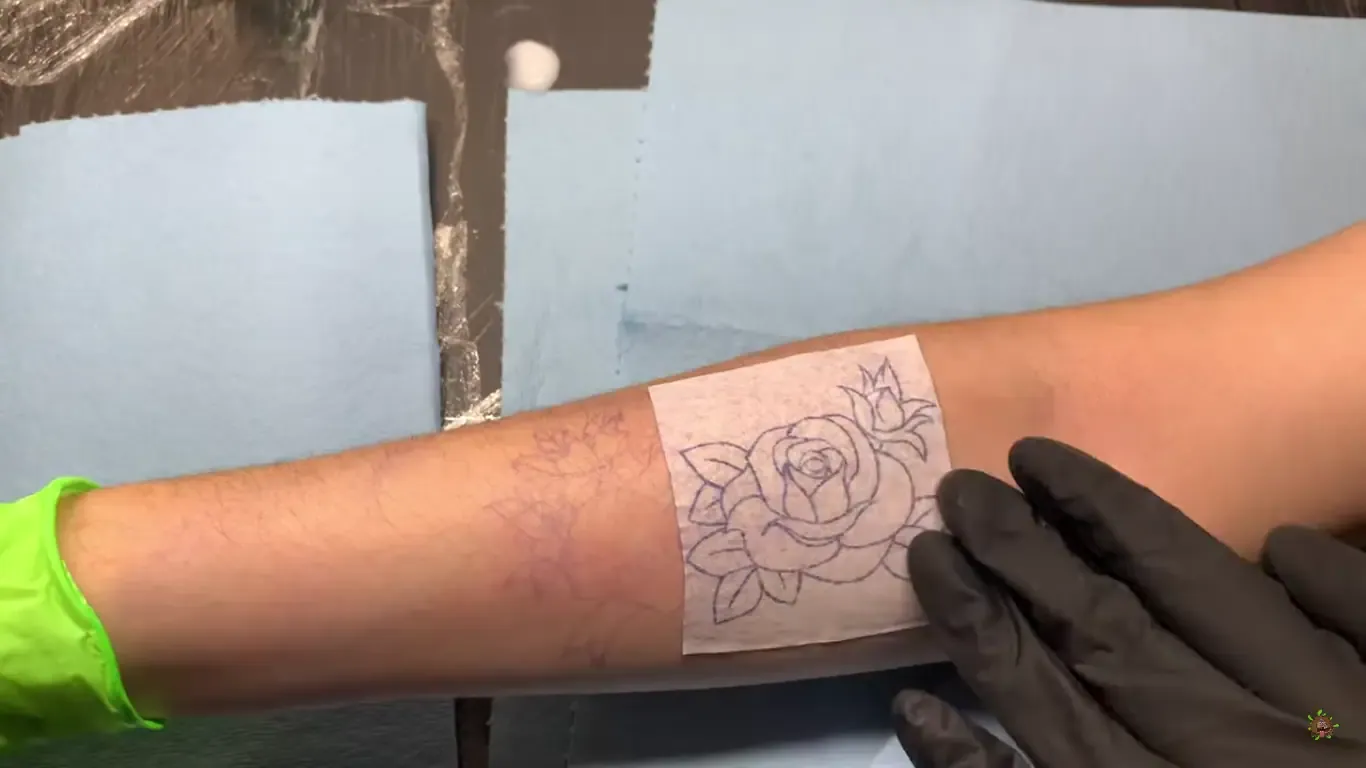Tattoo Stencil Not Transferring To Skin
Unprepared skin is most likely the reason your tattoo stencil isn’t transferring. For example, if the skin is excessively dry, oily, or not shaved properly, it won’t hold the stencil well. Sometimes, poor-quality stencils can also be the cause.
Even in some cases, stencil paper dries too quickly during the transfer process, which is why it doesn’t work. If the ink is too thin or too thick, it won’t stick properly to the skin. Moreover, incorrect application technique is also a common issue.
For example, inconsistent or excessive pressure during the process can lead to a distorted transfer. If you’d like to learn more about the reasons and solutions for why a tattoo stencil paper does not transfer to the skin, please read on for detailed information.
Important Components Of Tattoo Stencil
A stencil is an important part of the tattooing procedure, as it helps to get the perfect tattoo design without any error with ease. These papers are like a tattoo template, which works as guidelines for a tattoo artist to draw outlines of actual design. Stencil helps provide a precise and clear representation of the design before the tattooing process. Here are its components:
Stencil Paper: A stencil is a special type of paper that transfers a tattoo design to the skin. With this template, a tattoo artist can quickly outline the actual design.
Design or Image: It’s the actual design or shape that a client wants to get. Usually, the customer provides this or asks the artist to create it.
Stencil Machine or Printer: This special type of printer is used to transfer a design from stencil paper to the skin. Once applied to the skin, it creates an outline that the artist traces while creating the tattoo.
Transfer Solution: A special liquid gel is applied to stencil paper before transferring it to the skin. This liquid solution helps the design to stick with the skin during the tattooing session.
Stencil Application Tool: A stencil applicator is used to press the stencil onto the skin to ensure it adheres correctly.
Tattoo Stencil Not Transferring To Skin: Reasons And Solutions
Quick Overview of Problems and Solution
| Issue | Reasons | Solutions |
| Unprepared skin | The skin is oily The skin is not completely dry. The skin has not been shaved properly | Ensure that your skin is clean, completely dry, and properly shaved, with no oil or debris on it. |
| Stencil Dry Time | Stencil is not dry completely | Let it dry for a few minutes |
| Stencil Paper Quality | Poor-quality or expired stencil paper. Excessive moisture can cause it to adhere poorly | Use fresh and high-quality paper. Ensure that it is dry enough to adhere properly |
| Incorrect Application Techniques | Inconsistent or excessive pressure Incorrect placement or alignment errors | Apply consistent pressure. Apply it correctly. Ensure proper placement and alignment |
| Issue with Stencil Solution | The solution liquid dries quickly | Use a good quality stencil solution. Use your own homemade solution |
Reason 1: Unprepared Skin
One of the main reasons tattoo stencil is not transferring is inadequate skin preparation. Typically, dirty, oily, sweet, or not properly shaved skin prevents it from properly sticking. Even skincare products’ components can hinder this process. These agents create a barrier between skin and stencil, preventing the solution from adhering correctly.
Solution:
Therefore, in order to transfer it properly, you need to clean and prepare the skin thoroughly. Follow these instructions to make your skin well-prepared:
Step 1: Get Required Items. To start cleaning your skin properly, make sure you’re following skincare products:
- Clean towel
- Antibacterial soap
- Glycerine or any lotion
Step 2: Wash Your Hands. Washing hands before doing anything is always a good practice. Hand washing helps to stop the contamination of germs. Similarly, it will prevent transferring bacteria or dirt to your skin while transferring the paper.
Step 3: Select the Tattoo Area. Apply tattoo stencils on an area of your body where you want to get a tattoo. This means selecting the specific location for your tattoo design.
Step 4: Clean the skin properly. Now, wash your application skin with water and antibacterial soap, such as Dial Antibacterial Deodorant Soap. This process will remove germs, dirt, or residual substances from your skin.
Step 5: Shave the Area. Shave your skin if there are hairs before transferring the stencil paper. For shaving, you can use a disposable razor. This step is important, particularly if you have hairy skin, as hairs can prevent the stencil paper from adhering. However, please don’t make any cuts on tattoo skin, as it can lead to infection. Even later, it can slow down the tattoo’s healing process.
Step 7: Again clean the skin. After shaving, clean the application area again using soap and water. Then, gently dry it with a clean towel to ensure it’s completely dry before proceeding to the next step.
Step 8: Apply a thin layer of Glycerine. Applying Glycerine to the application area will help the stencil stick well, as it creates a smooth and hydrated surface on the skin. However, avoid using excessive Glycerine, which can cause the stencil to slide and blur. But don’t use any greasy lotion, as it can hinder the process by preventing the stencil from sticking.
Step 9: Allow the Skin to Dry. Once you’ve completed these steps, allow the skin enough time to dry completely.
Problem 2: Stencil Dry Time
This is the most common issue; I’ve observed it many times. Usually, after applying the tattoo stencil, we don’t allow it to dry completely before starting the tattooing process. As a result, it begins to lose its stickiness.
Solution: Once the stencil is applied, allow it to dry completely before starting the tattooing session.
Problem 3: Stencil Paper Quality
When it comes to stencil paper, there are various types available from different brands. However, they can be different in quality. If the stencil is not transferring onto the skin, there is a high chance that you are using a low-quality stencil.
Additionally, an expired stencil also won’t transfer to the skin properly. Furthermore, if the stencil becomes excessively wet or damp, it can lead to poor stickiness on your skin. This is most likely to occur when it comes into contact with moisture.
Solution:
- Always use high-quality transfer paper from trusted brands.
- Avoid using expired, old, or previously used paper.
- Ensure your hands are clean and dry before handling the paper to prevent moisture. Additionally, avoid touching the paper with wet fingers or hands. Furthermore, store stencil paper in a secure container or sealed it with plastic bag to protect it from environmental humidity.
Problem 4: Incorrect Application Techniques
Improper handling of transfer paper can lead to issues. Often, tattoo artists apply either excessive or too low pressure. As a result, it won’t transfer to the skin properly. Moreover, placing the paper in a position that isn’t properly aligned with the body’s contours can prevent its stickiness.
Solution:
When applying stencil paper, use even and enough pressure so it can stick well on the skin. Also, avoid doing it too quickly; it can lead to poor results. Apply it smoothly across the skin at the correct angle to ensure proper placement and alignment. Moreover, avoid abrupt or jerky motions while applying, as this can result in misalignment.
Problem 5: Issue With Stencil Solution
Most of the time, the solution dries too quickly before being applied to the skin. In such cases, the design doesn’t transfer well onto the skin. In addition, excessively moist or too dry skin resists the stencil solution not to work properly.
Solution:
Use a high-quality solution, like Stencil STUFF or Electrum that doesn’t dry too quickly. Alternatively, you can create your solution at home. Before transferring the paper, apply a good amount of solution to prevent it from drying too quickly. If the skin is too wet or oily, use Glycerine to help the solution stick well.
Similarly, if your skin is too dry, apply a moisturizing lotion like A&D Ointment to the application area. After using the lotion on the skin, allow it to dry completely. Once it has dried, apply the stencil paper again. However, don’t apply greasy lotion as it will resist the solution.
How To Transfer Tattoo Stencil To Skin Correctly
To apply the stencil correctly, following the proper directions and instructions is important.
Clean and Prepare the Skin: Clean the skin area where you want to apply the stencil paper. You remove any dirt, oil, or other buildup particles that can make it resistant to stencil paper. Once the skin is clean, dry it using a clean towel and allow it a few minutes to dry completely.
Shave the AreaArea (if needed): If you have hair on your skin, shave the Area well, so transfer paper stick well on the skin. For shaving you can use a disposable razor for shaving. However, while shaving, be careful not to make any cuts, as this can lead to infections. These cuts can also cause more discomfort and pain during the tattooing process.
Prepare the Stencil: If you have a tattoo design printer, load your design into it and print it on stencil paper. Once you get the printed design, trim or cut it according to the application area to make it more manageable.
Position the Stencil on the Skin: Now, carefully apply the stencil paper on cleaned and prepared skin on the area where you want to get the tattoo. But make sure it’s centered and aligned. Once you apply it, gently press the stencil paper against your skin so it can stick well.
Peel Off the Stencil: Once it sticks well, lift the paper from your skin and check if the design has transferred correctly.
Touch Up the Stencil (if needed): If any part of the design doesn’t transfer properly or is dull in appearance, you can touch it up using a fine-point pen or marker.
Let it Dry Completely: After applying the stencil, allow it to dry entirely before tattooing.
Tattoo Over the Stencil: Once it dries completely, you can start the tattooing process.
FAQs
Why is my transfer paper transferring?
There could be several reasons why stencil paper is not transferring. For example, skin is unprepared, like it’s oily, too dry, or not shaved well. Poor quality or expired paper can be another reason. Sometimes, there can be a solution issue, such as drying too quickly or excessively wet.
Do you put Vaseline over a tattoo stencil?
I mostly used Vaseline while applying stencil transfer on the customer’s skin. You can put a thin layer of Vaseline over a tattoo stencil. Once it is applied to the skin, gently clean the excessive Vaseline.
Here are some benefits of using Vaseline over a tattoo stencil:
- Stencil Durability: It can help protect the stencil from fading or smudging due to excess ink or sweat during tattooing.
- Clarity: Vaseline helps to make an outline of the stencil more clear and shape
- Less Irritation: Many experts believe Vaseline helps to reduce irritation and redness during tattooing sessions.

Evelyn Grace
Evelyn Grace ✍️ Tattoo artist & writer @ Tattoogaze.com. Specializes in black & grey tattoos. Creates timeless designs with clients to craft meaningful pieces. Ask me anything!

Evelyn Grace
Evelyn Grace ✍️ Tattoo artist & writer @ Tattoogaze.com. Specializes in black & grey tattoos. Creates timeless designs with clients to craft meaningful pieces. Ask me anything!

